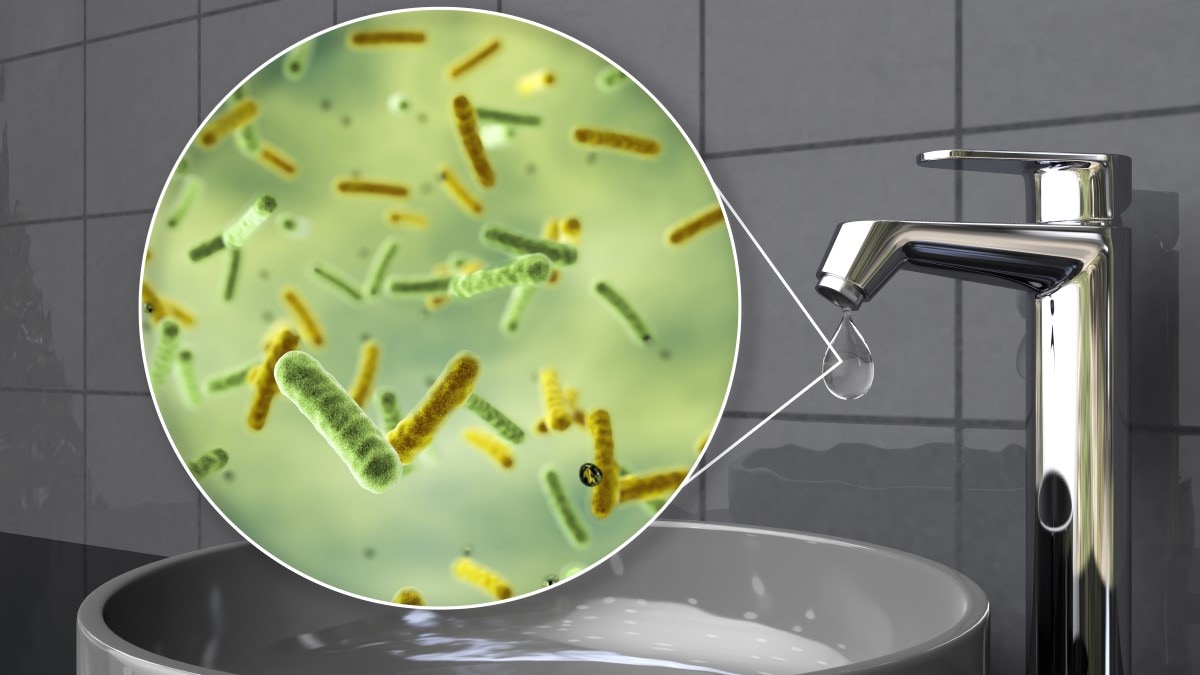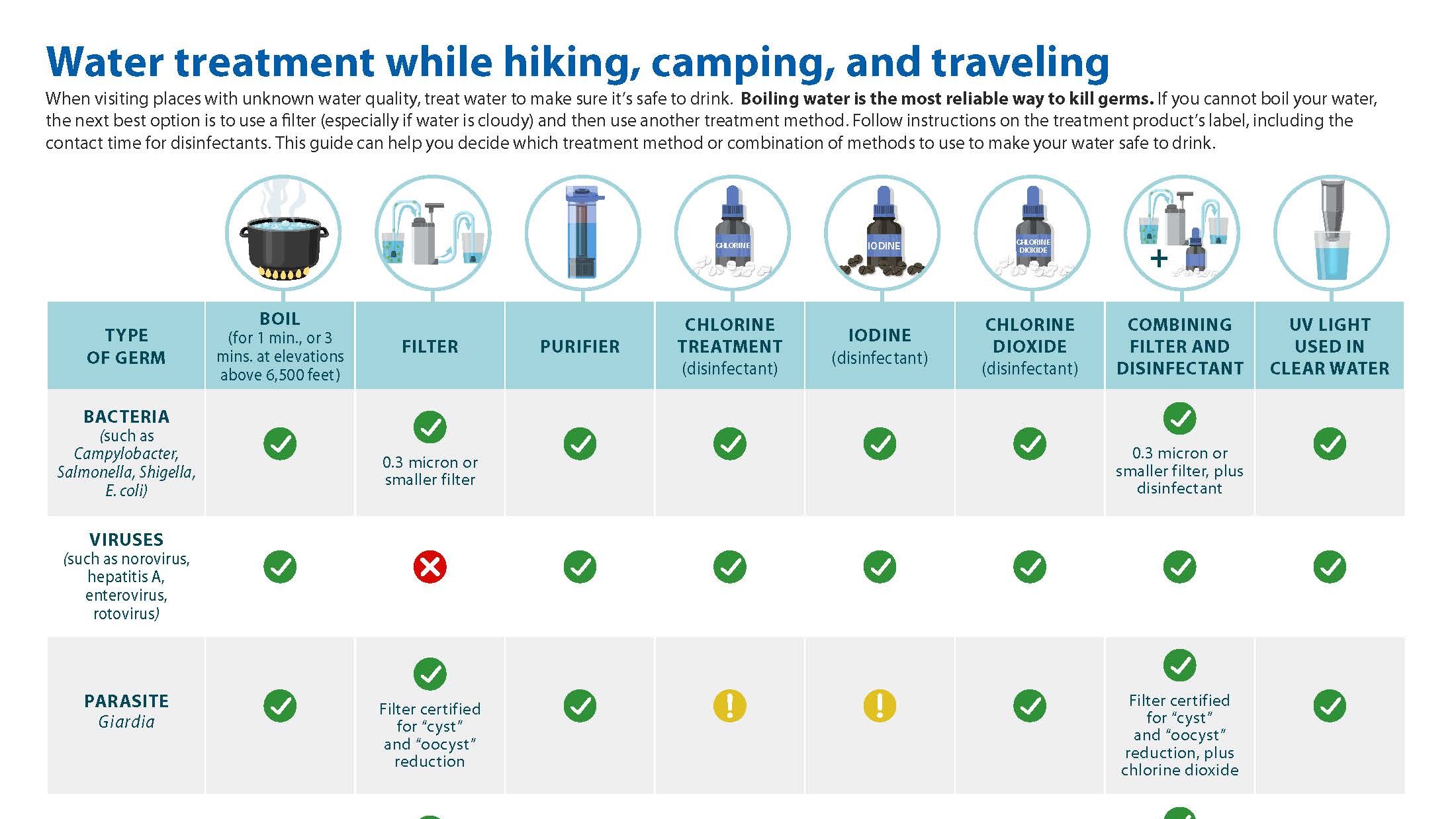Key points
- Public tap water in the United States is regulated and usually safe to drink.
- However, sometimes tap water gets contaminated with germs that can make you sick.
- Contact your drinking water utility or health department if you think your tap water is contaminated with germs.

Overview
Find information below about the germs that most often contaminate tap water and cause disease, and how to remove or control them.
Boiling is the best way to kill germs in water.
Cryptosporidium (Crypto)
Common sources
Poop from infected people or animals can get into the water from:
- Sewage overflows
- Sewage systems that are not working properly
- Polluted stormwater runoff
- Water runoff from farms
Removing Crypto from water
To remove Crypto from drinking water:
- Boil your water for 1 minute (at elevations above 6,500 feet, boil for 3 minutes),
- Use a filter certified to remove Cryptosporidium, or
- Treat water using reverse osmosis, UV light, or ozone
Symptoms of Crypto infection
The most common symptom of Crypto is watery diarrhea.
Campylobacter
Common sources
Poop from infected people or animals can get into the water from:
- Sewage overflows
- Sewage systems that are not working properly
- Polluted stormwater runoff
- Water runoff from farms
Removing Campylobacter from water
To remove Campylobacter from drinking water:
- Boil your water for 1 minute (at elevations above 6,500 feet, boil for 3 minutes),
- Disinfect water using chemicals,
- Use a filter designed to remove bacteria, or
- Use another water treatment method that removes bacteria
Symptoms of Campylobacter infection
- Diarrhea
- Fever
- Stomach cramps
E. coli O157
Common sources
E. coli O157 often comes from cattle farms, where it can live in the gut (intestines) of healthy cows. Cow poop containing E. coli O157 can wash into rivers or other water sources from these farms.
Less commonly, poop from an infected person or animal can get into the water from:
- Sewage overflows
- Sewage systems that are not working properly
- Polluted storm water runoff
- Water runoff from other types of farms
Removing E. coli O157 from water
To remove E. coli O157 from drinking water:
- Boil your water for 1 minute (at elevations above 6,500 feet, boil for 3 minutes),
- Disinfect water using chemicals,
- Use a filter designed to remove bacteria, or
- Use another water treatment method that removes bacteria
Symptoms of E. coli O157 infection
- Bloody diarrhea
- Severe stomach cramps
- Throwing up
Enterovirus
Common sources
Poop from infected people can get into the water from:
- Sewage overflows
- Sewage systems that are not working properly
- Polluted storm water runoff
Removing enterovirus from water
To remove enterovirus from drinking water, boil your water for 1 minute. At elevations above 6,500 feet, boil water for 3 minutes.
Disinfectants do not work well to kill enteroviruses and enteroviruses are too small to be removed by most water filters.
Symptoms of enterovirus infection
Symptoms are often mild and commonly include:
- Fever
- Runny nose, sneezing, cough
- Skin rash
- Mouth blisters
- Body and muscle aches
Giardia
Common sources
Poop from infected people or animals can get into the water from:
- Sewage overflows
- Sewage systems that are not working properly
- Polluted stormwater runoff
- Water runoff from farms
Removing Giardia from water
To remove Giardia from drinking water:
- Boil your water for 1 minute (at elevations above 6,500 feet, boil for 3 minutes),
- Use a filter certified to remove Giardia or Cryptosporidium, or
- Treat water using reverse osmosis, UV light, or ozone
Symptoms of Giardia infection
Diarrhea is the most common symptom.
Hepatitis A virus
Common sources
Poop from infected people can get into the water from:
- Sewage overflows
- Sewage systems that are not working properly
- Polluted stormwater runoff
Removing hepatitis A virus from water
To remove hepatitis A virus from drinking water:
- Boil your water for 1 minute (at elevations above 6,500 feet, boil for 3 minutes) or
- Disinfect water using chemicals
Hepatitis A virus is too small to be removed by most water filters.
Symptoms of Hepatitis A
- Dark urine or clay-colored poop
- Diarrhea
- Feeling tired
- Fever
- Joint pain
- Loss of appetite
- Nausea, stomach pain, throwing up
- Yellow skin or eyes (jaundice)
Legionella
Common sources
Legionella bacteria are found naturally in freshwater environments, like lakes and streams.
The bacteria can become a health risk when they grow and spread in:
- Building water systems (such as faucets or hot water heaters)
- Devices that create small drop of water (such as cooling towers, hot tubs, or decorative fountains)
Most illness outbreaks linked to Legionella are in buildings with large, complex water systems. These buildings include hotels, long-term care facilities, and hospitals.
Controlling Legionella in tap water
To control the growth and spread of Legionella in building water systems, owners and managers should:
- Maintain water systems
- Implement a water management program with Legionella control measures
You can also take steps at home to reduce the growth and spread of Legionella and other germs in your water pipes and devices.
Symptoms of Legionella infection
- Cough
- Fever
- Headaches
- Muscle aches
- Shortness of breath
Norovirus
Common sources
Poop from infected people can get into the water from:
- Sewage overflows
- Sewage systems that are not working properly
- Polluted stormwater runoff
Removing norovirus from water
To remove norovirus from drinking water, boil your water for 1 minute. At elevations above 6,500 feet, boil for 3 minutes.
Noroviruses are somewhat resistant to chlorine, so check with your health department about disinfection. Noroviruses are too small to be removed by most water filters.
Symptoms of norovirus infection
- Diarrhea
- Throwing up
- Nausea
- Stomach pain
Rotavirus
Common sources
Poop from infected people can get into the water from:
- Sewage overflows
- Sewage systems that are not working properly
- Polluted stormwater runoff
Removing rotavirus from water
To remove rotavirus from drinking water:
- Boil your water for 1 minute (at elevations above 6,500 feet, boil for 3 minutes) or
- Disinfect water using chemicals
Rotavirus is too small to be removed by most water filters.
Symptoms of rotavirus infection
- Severe watery diarrhea
- Throwing up
- Fever
- Stomach pain
Salmonella
Common sources
Poop from infected people or animals can get into the water from:
- Sewage overflows
- Sewage systems that are not working properly
- Polluted stormwater runoff
- Water runoff from farms
Removing Salmonella from water
To remove Salmonella from drinking water:
- Boil your water for 1 minute (at elevations above 6,500 feet, boil for 3 minutes),
- Disinfect water using chemicals,
- Use a filter designed to remove bacteria, or
- Use another water treatment method that removes bacteria
Symptoms of Salmonella infection
- Diarrhea (that can be bloody)
- Fever
- Stomach cramps
Shigella
Common sources
Poop from infected people can get into the water from:
- Sewage overflows
- Sewage systems that are not working properly
- Polluted stormwater runoff
Removing Shigella from water
To remove Shigella from drinking water:
- Boil your water for 1 minute (at elevations above 6,500 feet, boil for 3 minutes),
- Disinfect water using chemicals,
- Use a filter designed to remove bacteria, or
- Use another water treatment method that removes bacteria
Symptoms of Shigella infection
- Diarrhea (that can be bloody)
- Fever
- Stomach pain
- Feeling the need to poop even when your bowels are empty
Resources
- About Home Water Treatment Systems
- About Choosing Home Water Filters
- How to Make Water Safe in an Emergency
- Guidelines for Treating Well Water
- Home Drinking Water Testing | U.S. EPA

